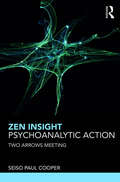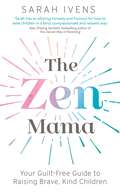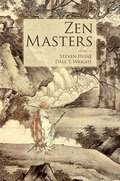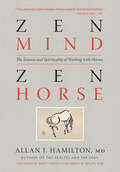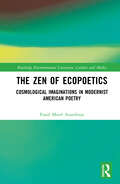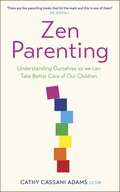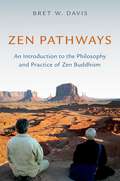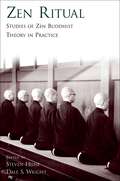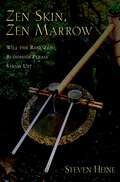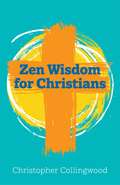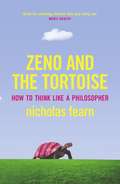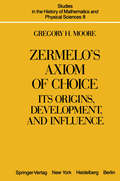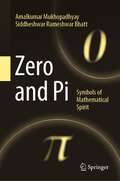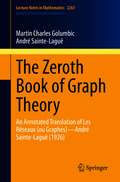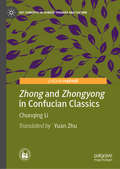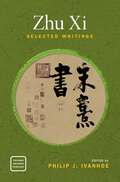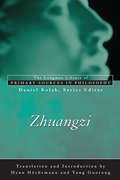- Table View
- List View
Zen Insight, Psychoanalytic Action: Two Arrows Meeting
by Seiso Paul CooperDrawing from original source material, contemporary scholarship, and Wilfred Bion’s psychoanalytic writings, Zen Insight, Psychoanalytic Action: Two Arrows Meeting introduces the Zen notion of "gūjin," or total exertion, and elaborates a realizational perspective that integrates Zen Buddhism and psychoanalysis. Developed by the thirteenth century Zen teacher and founder of the Japanese Soto Zen school, Eihei Dogen, gūjin finds expression and is referenced in various contemporary scholarly and religious commentaries. This book explains this pivotal Zen concept and addresses themes by drawing from translated source material, academic scholarship, traditional Zen kōans and teaching stories, extensive commentarial literature, interpretive writings by contemporary Soto Zen teachers, psychoanalytic theory, clinical material, and poetry, as well as the author’s thirty years of personal experience as a psychoanalyst, supervisor, psychoanalytic educator, ordained Soto Zen priest, and transmitted Soto Zen teacher. From a realizational perspective that integrates Zen and psychoanalytic concepts, the book addresses anxiety-driven interferences to deepened Zen practice, extends the scope and increases the effectiveness of clinical work for the psychotherapist, and facilitates deepened experiences for both the Buddhist and the secular meditation practitioner. Two Arrows Meeting will be of great interest to researchers in the fields of Zen Buddhism and psychoanalysis. It will also appeal to meditation practitioners and psychoanalysts in practice and training.
The Zen Mama: Your guilt-free guide to raising brave, kind children
by Sarah IvensLet go of parenting expectations and fears to raise courageous, confident children.The Zen Mama philosophy is that mother and child complement each other in adventures and experiences, always putting safety first but without getting caught up in the anxieties, drama, impossible expectations and mental baggage that too often comes along with modern parenting. Learning to become a Zen Mama will help you grow and nurture a Zen Child - someone who isn't afraid to be different, who can stand up for himself or his friends, and can travel the world and experiment with new things without being overwhelmed with self-doubt or being scared. Full of facts, actionable advice and practical tips, this book will be about combining the heart and the head with what works for you and your family, not comparing yourselves to others or meeting a societal standard. It will support and nurture the mother's journey like a wise and sympathetic friend and offers ideas and experience rather than judgement.The Zen Mama will help you to find your purpose as a mother. It will instil the self-belief you need to help create a resilient, creative, caring and smart child - and help to survive the journey.
Zen Masters
by Steven Heine Dale WrightExtending their successful series of collections on Zen Buddhism, Heine and Wright present a fifth volume, on what may be the most important topic of all - Zen Masters. Following two volumes on Zen literature (Zen Classics and The Zen Canon) and two volumes on Zen practice (The Koan and Zen Ritual) they now propose a volume on the most significant product of the Zen tradition - the Zen masters who have made this kind of Buddhism the most renowned in the world by emphasizing the role of eminent spiritual leaders and their function in establishing centers, forging lineages, and creating literature and art. Zen masters in China, and later in Korea and Japan, were among the cultural leaders of their times. Stories about their comportment and powers circulated widely throughout East Asia. In this volume ten leading Zen scholars focus on the image of the Zen master as it has been projected over the last millennium by the classic literature of this tradition. Each chapter looks at a single prominent master. Authors assess the master's personality and charisma, his reported behavior and comportment, his relationships with teachers, rivals and disciplines, lines of transmission, primary teachings, the practices he emphasized, sayings and catch-phrases associated with him, his historical and social context, representations and icons, and enduring influences.
Zen Masters: Koans Of The Zen Masters
by Steven Heine Dale WrightExtending their successful series of collections on Zen Buddhism, Heine and Wright present a fifth volume, on what may be the most important topic of all - Zen Masters. Following two volumes on Zen literature (Zen Classics and The Zen Canon) and two volumes on Zen practice (The Koan and Zen Ritual) they now propose a volume on the most significant product of the Zen tradition - the Zen masters who have made this kind of Buddhism the most renowned in the world by emphasizing the role of eminent spiritual leaders and their function in establishing centers, forging lineages, and creating literature and art. Zen masters in China, and later in Korea and Japan, were among the cultural leaders of their times. Stories about their comportment and powers circulated widely throughout East Asia. In this volume ten leading Zen scholars focus on the image of the Zen master as it has been projected over the last millennium by the classic literature of this tradition. Each chapter looks at a single prominent master. Authors assess the master's personality and charisma, his reported behavior and comportment, his relationships with teachers, rivals and disciplines, lines of transmission, primary teachings, the practices he emphasized, sayings and catch-phrases associated with him, his historical and social context, representations and icons, and enduring influences.
Zen Mind, Zen Horse: The Science and Spirituality of Working with Horses
by Allan J. Hamilton MDDrawing on his scientific understanding of the brain, noted neurosurgeon and lifelong horseman Allan Hamilton offers a new approach to horse training based on understanding the intuitive, nonverbal, right-brain communication process of horses.
The Zen of Ecopoetics: Cosmological Imaginations in Modernist American Poetry (Routledge Environmental Literature, Culture and Media)
by Enaiê Mairê AzambujaThis book is the first comprehensive study investigating the cultural affinities and resonances of Zen in early twentieth-century American poetry and its contribution to current definitions of ecopoetics, focusing on four key poets: William Carlos Williams, Marianne Moore, Wallace Stevens, and E.E. Cummings. Bringing together a range of texts and perspectives and using an interdisciplinary approach that draws on Eastern and Western philosophies, including Zen and Taoism, posthumanism and new materialism, this book adds to and extends the field of ecocriticism into new debates. Its broad approach, informed by literary studies, ecocriticism, and religious studies, proposes the expansion of ecopoetics to include the relationship between poetic materiality and spirituality. It develops ‘cosmopoetics’ as a new literary-theoretical concept of the poetic imagination as a contemplative means to achieving a deeper understanding of the human interdependence with the non-human. Addressing the critical gap between materialism and spirituality in modernist American poetry, The Zen of Ecopoetics promotes new forms of awareness and understanding about our relationship with non-human beings and environments. It will be of interest to scholars, researchers, and students in ecocriticism, literary theory, poetry, and religious studies.
The Zen of Ecopoetics: Cosmological Imaginations in Modernist American Poetry (Routledge Environmental Literature, Culture and Media)
by Enaiê Mairê AzambujaThis book is the first comprehensive study investigating the cultural affinities and resonances of Zen in early twentieth-century American poetry and its contribution to current definitions of ecopoetics, focusing on four key poets: William Carlos Williams, Marianne Moore, Wallace Stevens, and E.E. Cummings. Bringing together a range of texts and perspectives and using an interdisciplinary approach that draws on Eastern and Western philosophies, including Zen and Taoism, posthumanism and new materialism, this book adds to and extends the field of ecocriticism into new debates. Its broad approach, informed by literary studies, ecocriticism, and religious studies, proposes the expansion of ecopoetics to include the relationship between poetic materiality and spirituality. It develops ‘cosmopoetics’ as a new literary-theoretical concept of the poetic imagination as a contemplative means to achieving a deeper understanding of the human interdependence with the non-human. Addressing the critical gap between materialism and spirituality in modernist American poetry, The Zen of Ecopoetics promotes new forms of awareness and understanding about our relationship with non-human beings and environments. It will be of interest to scholars, researchers, and students in ecocriticism, literary theory, poetry, and religious studies.
Zen Parenting: Understanding Ourselves so we can Take Better Care of Our Children
by Cathy Cassani Adams'There are few parenting books that hit the mark and this is one of them!' Dr ShefaliWe can't always plan for what's next - that's been made more and more clear in the past few years. The truth is that life is never predictable, especially for parents. What is possible is an unlimited capacity for compassion and caring - for yourself and your children. As you navigate the uncertainty with openness and humility, you find the clarity, connection, and community that is Zen Parenting. Using the seven chakras, therapist Cathy Cassani Adams discusses parenting issues such as school pressure, self-care, emotional intelligence, anxiety, sexuality and gender, and more, while offering concrete examples and strategies to help you wake up to your life as a parent. Zen Parenting guides you to:- Establish your physical, emotional and mental foundation- Practice creativity and how to access your emotions- Develop your sense of self and allow your kids to do the same- Experience openheartedness, empathy and compassion- Discover genuine and meaningful communication- Explore mindfulness, meditation and your own intuition- Connect to something greater than yourself
Zen Pathways: An Introduction to the Philosophy and Practice of Zen Buddhism
by Bret W. DavisThis book offers an in-depth introduction to the philosophy and practice of Zen Buddhism. Bret Davis explores the philosophical implications of Zen teachings and koans, comparing and contrasting these with other Asian as well as Western religions and philosophies. He relates traditional Zen teachings and practices to our twenty-first century lives. In addition to being a scholarly and philosophical introduction to Zen, the book provides concrete instructions for beginning a practice of Zen meditation. Its twenty-four chapters treat such philosophical topics as the self, nature, art, morality, and language, as well as basic Buddhist teachings such as the middle way and karma. Davis introduces the Zen based philosophies of the Kyoto School and also engages in interreligious dialogue with Christianity and other religions, as well as with other schools of Buddhism. The concluding chapter reviews the path of Zen practice and enlightenment by way of commenting on the beloved Zen classic, The Ten Oxherding Pictures. The book can be read in its entirety as a coherently organized introduction to the philosophy and practice of Zen, or chapters can be read independently according to the reader's specific interests.
Zen Pathways: An Introduction to the Philosophy and Practice of Zen Buddhism
by Bret W. DavisThis book offers an in-depth introduction to the philosophy and practice of Zen Buddhism. Bret Davis explores the philosophical implications of Zen teachings and koans, comparing and contrasting these with other Asian as well as Western religions and philosophies. He relates traditional Zen teachings and practices to our twenty-first century lives. In addition to being a scholarly and philosophical introduction to Zen, the book provides concrete instructions for beginning a practice of Zen meditation. Its twenty-four chapters treat such philosophical topics as the self, nature, art, morality, and language, as well as basic Buddhist teachings such as the middle way and karma. Davis introduces the Zen based philosophies of the Kyoto School and also engages in interreligious dialogue with Christianity and other religions, as well as with other schools of Buddhism. The concluding chapter reviews the path of Zen practice and enlightenment by way of commenting on the beloved Zen classic, The Ten Oxherding Pictures. The book can be read in its entirety as a coherently organized introduction to the philosophy and practice of Zen, or chapters can be read independently according to the reader's specific interests.
Zen Ritual: Studies of Zen Buddhist Theory in Practice
by Steven Heine Dale S. WrightWhen books about Zen Buddhism began appearing in Western languages just over a half-century ago, there was no interest whatsoever in the role of ritual in Zen. Indeed, what attracted Western readers' interest was the Zen rejection of ritual. The famous 'Beat Zen' writers were delighted by the Zen emphasis on spontaneity as opposed to planned, repetitious action, and wrote inspirationally about the demythologized, anti-ritualized spirit of Zen. Quotes from the great Zen masters supported this understanding of Zen, and led to the fervor that fueled the opening of Zen centers throughout the West. Once Western practitioners in these centers began to practice Zen seriously, however, they discovered that zazen - Zen meditation - is a ritualized practice supported by centuries-old ritual practices of East Asia. Although initially in tension with the popular anti-ritual image of ancient Zen masters, interest in Zen ritual has increased along with awareness of its fundamental role in the spirit of Zen. Eventually, Zen practitioners would form the idea of no-mind, or the open and awakened state of mind in which ingrained habits of thinking give way to more receptive, direct forms of experience. This notion provides a perspective from which ritual could gain enormous respect as a vehicle to spiritual awakening, and thus this volume seeks to emphasize the significance of ritual in Zen practice. Containing 9 articles by prominent scholars about a variety of topics, including Zen rituals kinhin and zazen, this volume covers rituals from the early Chan period to modern Japan. Each chapter covers key developments that occurred in the Linji/Rinzai and Caodon/ Soto schools of China and Japan, describing how Zen rituals mold the lives and characters of its practitioners, shaping them in accordance with the ideal of Zen awakening. This volume is a significant step towards placing these practices in a larger historical and analytical perspective.
Zen Skin, Zen Marrow: Will the Real Zen Buddhism Please Stand Up?
by Steven HeineSince Zen Buddhism first captivated the attention of Western seekers the dominant discourse about this sect has been romantic, idealistic, and utopian. The essence of Zen has been described as ineffable, holistic, and promoting social harmony. In recent years, however, some scholars have begun to examine Zen through the lenses of historical and cultural criticism, producing a sharp challenge to the traditional view. These clashing viewpoints are now entrenched in two warring camps, and their exponents talk past each other with virtually no constructive interaction. In this book, Steven Heine argues that a constructive compromise is possible. He focuses on three principal areas of disagreement: (1) the role of language and discourse in a tradition that claims to be 'outside words and letters,' yet has produced a voluminous body of texts, (2) the function of rituals and objects of worship to gain world benefit in a tradition supposedly founded on unmediated experience attained in an iconoclastic and ascetic environment, (3) the impact of a tradition that espouses peace and harmony on social issues such as class and gender discrimination and on nationalism and imperialism in Japan. Avoiding the stagnant polarization that characterizes most encounters between Zen traditionalists and their critics, he suggests ways in which these two perspectives can complement each other in a more balanced and nuanced alternative position.
Zen War Stories (Routledge Critical Studies in Buddhism)
by Brian VictoriaFollowing the critically acclaimed Zen at War (1997), Brian Victoria explores the intimate relationship between Japanese institutional Buddhism and militarism during the Second World War.Victoria reveals for the first time, through examination of the wartime writings of the Japanese military itself, that the Zen school's view of life and death was deliberately incorporated into the military's programme of 'spiritual education' in order to develop a fanatical military spirit in both soldiers and civilians. Furthermore, that D. T. Suzuki, the most famous exponent of Zen in the West, is shown to have been a wartime proponent of this Zen-inspired viewpoint which enabled Japanese soldiers to leave for the battlefield already resigned to death. Victoria takes us onto the naval battlefield in the company of warrior-monk and Rinzai Zen Master Nakajima Genjô. We view the war in China through the eyes of a Buddhist military chaplain. The book also examines the relationship to Buddhism of Japan's seven Class-A war criminals who were hung by the Tokyo War Crimes Tribunal in 1948.A highly controversial study, this book will be of interest, first and foremost, to students of Zen as well as all those studying the history of this period, not to mention anyone concerned with the perennial question of the 'proper' relationship between religion and the state.
Zen War Stories (Routledge Critical Studies in Buddhism)
by Brian VictoriaFollowing the critically acclaimed Zen at War (1997), Brian Victoria explores the intimate relationship between Japanese institutional Buddhism and militarism during the Second World War.Victoria reveals for the first time, through examination of the wartime writings of the Japanese military itself, that the Zen school's view of life and death was deliberately incorporated into the military's programme of 'spiritual education' in order to develop a fanatical military spirit in both soldiers and civilians. Furthermore, that D. T. Suzuki, the most famous exponent of Zen in the West, is shown to have been a wartime proponent of this Zen-inspired viewpoint which enabled Japanese soldiers to leave for the battlefield already resigned to death. Victoria takes us onto the naval battlefield in the company of warrior-monk and Rinzai Zen Master Nakajima Genjô. We view the war in China through the eyes of a Buddhist military chaplain. The book also examines the relationship to Buddhism of Japan's seven Class-A war criminals who were hung by the Tokyo War Crimes Tribunal in 1948.A highly controversial study, this book will be of interest, first and foremost, to students of Zen as well as all those studying the history of this period, not to mention anyone concerned with the perennial question of the 'proper' relationship between religion and the state.
Zen Wisdom for Christians
by Christopher CollingwoodAs spiritual paths, Zen and Christianity can learn from one another. In this book, Anglican priest and Zen teacher Christopher Collingwood sets out how Zen can return Christians to their roots with renewed energy, and allow others to consider Christianity in a new and more favourable light. For the many Christians searching for a greater depth of spirituality, Zen offers a way to achieve openness. Drawing on Zen experience and the teachings of Jesus as depicted in the gospels, Zen Wisdom for Christians enables Christians to explore avenues of thought and experience that are fresh and creative. Using examples of Zen koans and Zen readings of Christian texts, the author provides a radical reorientation of life - away from one based on self-centredness and the notion of a separate, isolated self, to a way that is inclusive and at one with all.Zen Wisdom for Christians proves that the practice of Zen can lead Christians towards deeper spirituality and enhance religious experience through mutual appreciation, in a way that is truly eye-opening and life-changing.
Zen Wisdom for Christians
by Christopher CollingwoodAs spiritual paths, Zen and Christianity can learn from one another. In this book, Anglican priest and Zen teacher Christopher Collingwood sets out how Zen can return Christians to their roots with renewed energy, and allow others to consider Christianity in a new and more favourable light. For the many Christians searching for a greater depth of spirituality, Zen offers a way to achieve openness. Drawing on Zen experience and the teachings of Jesus as depicted in the gospels, Zen Wisdom for Christians enables Christians to explore avenues of thought and experience that are fresh and creative. Using examples of Zen koans and Zen readings of Christian texts, the author provides a radical reorientation of life - away from one based on self-centredness and the notion of a separate, isolated self, to a way that is inclusive and at one with all.Zen Wisdom for Christians proves that the practice of Zen can lead Christians towards deeper spirituality and enhance religious experience through mutual appreciation, in a way that is truly eye-opening and life-changing.
Zeno and the Tortoise: How To Think Like A Philosopher
by Nicholas FearnA witty and irreverent guide to the key ideas and methods of the world's greatest thinkers.Zeno and the Tortoise explains not just who each philosopher was and what he thought, but exactly how he came to think in the way that he did. Nicholas Fearn presents philosophy as a collection of tools - from Ockham's Razor to Hume's Fork - each of which can be brought to bear on any number of predicaments. Written in twenty-five short chapters, each readable during the journey to work, Zeno and the Tortoise is an ideal course in intellectual self-defence.
Zermelo’s Axiom of Choice: Its Origins, Development, and Influence (Studies in the History of Mathematics and Physical Sciences #8)
by G.H. MooreThis book grew out of my interest in what is common to three disciplines: mathematics, philosophy, and history. The origins of Zermelo's Axiom of Choice, as well as the controversy that it engendered, certainly lie in that intersection. Since the time of Aristotle, mathematics has been concerned alternately with its assumptions and with the objects, such as number and space, about which those assumptions were made. In the historical context of Zermelo's Axiom, I have explored both the vagaries and the fertility of this alternating concern. Though Zermelo's research has provided the focus for this book, much of it is devoted to the problems from which his work originated and to the later developments which, directly or indirectly, he inspired. A few remarks about format are in order. In this book a publication is indicated by a date after a name; so Hilbert 1926, 178 refers to page 178 of an article written by Hilbert, published in 1926, and listed in the bibliography.
Zero and Pi: Symbols of Mathematical Spirit
by Amalkumar Mukhopadhyay Siddheshwar Rameshwar BhattThe book, divided into two major parts, discusses the evolution of the concept and symbols of zero and the history of pi. Both the topics are discussed from the Neolithic Age to the nineteenth century. The book also clears the assumption that Johann Heinrich Lambert (AD 1761) only invented the irrationality of pi by crediting Lambert jointly with André Marie Legendre (AD 1794).Part 1, consisting of six stages spread in six chapters, meets a challenge to the authors as eminent scholars of the history of mathematics have diverse opinions based on conjectures. This part primarily discusses how the symbol O, in the Vedic religious practices, considered a replica of the universe prescribed for meditation on the unknown Brahman (conceived of as the space supreme in the Upanishads), was later transcended to the symbol of an unknown quantity in mathematics along with a dot for zero in an arena of atheism. It also highlights how the zero notation and the decimal system of Indian numerals embellished with the algebraic thoughts of Brahmagupta passed on to China and Europe via Arabia. Topics in this part have traced the development from the origin to the final form as seen today after the western practice and try to put an end to the long-standing debate over history. Appendices contain the Sanskrit verses (transliterated with meanings into English) along with the essential mathematical deduction referred to in the body of the part to help the reader to have a better understanding.Part 2 speaks of a novel idea of unveiling the nature of pi interwoven with threads of historical ups and downs in the world scenario. This part, containing five chapters, collects all available up-to-date data in every field of history to make the presentation complete in all respects. This part discusses the origin of the definition of pi as the rim of a wheel is thrice its diameter at the Indus Valley in the fourth millennium BC. This part also discusses the enlightenment of China in circle-squaring (classical method), Indian mathematics with astronomical knowledge along the Buddhist channel, and India’s discovering circumference/diameter as a non-Euclidean number.
The Zeroth Book of Graph Theory: An Annotated Translation of Les Réseaux (ou Graphes)—André Sainte-Laguë (1926) (Lecture Notes in Mathematics #2261)
by Martin Charles Golumbic André Sainte-LaguëMarking 94 years since its first appearance, this book provides an annotated translation of Sainte-Laguë's seminal monograph Les réseaux (ou graphes), drawing attention to its fundamental principles and ideas. Sainte-Laguë's 1926 monograph appeared only in French, but in the 1990s H. Gropp published a number of English papers describing several aspects of the book. He expressed his hope that an English translation might sometime be available to the mathematics community. In the 10 years following the appearance of Les réseaux (ou graphes), the development of graph theory continued, culminating in the publication of the first full book on the theory of finite and infinite graphs in 1936 by Dénes König. This remained the only well-known text until Claude Berge's 1958 book on the theory and applications of graphs. By 1960, graph theory had emerged as a significant mathematical discipline of its own. This book will be of interest to graph theorists and mathematical historians.
Zhong and Zhongyong in Confucian Classics (Key Concepts in Chinese Thought and Culture)
by Chunqing LiThis Key Concept pivot explores the trajectory of the semantic generation and evolution of two core concepts of ancient Chinese Confucianism, ‘Zhong’ (middle) and ‘Zhongyong’ (golden mean). In the pre-Qin period, Confucius advocated ‘middle line’ and ‘golden mean’ as the highest standards for gentlemanly behaviour and culture. In The Doctrine of the Mean the Confucian classic of the late Warring States Period, ‘middle’ obtained the ontological meaning of ‘great fundamental virtues of the world’, due to the influence of Taoism and Yinyang School. It became not only the norm of human behaviours, but also the law governing the operation of heaven and earth. Since then, idealist Confucian scholars of the Song and Ming dynasties have developed the meaning of ‘middle’ from the perspective of the relationships between heaven and man, a fundamental norm of Confucian ethics.
Zhu Xi: Selected Writings (Oxford Chinese Thought)
by Philip J. IvanhoeThis volume contains nine chapters of translation, by a range of leading scholars, focusing on core themes in the philosophy of Zhu Xi (1130-1200), one of the most influential Chinese thinkers of the later Confucian tradition. It includes an Introduction to Zhu's life and thought, a chronology of important events in his life, and a list of key terms of art. Zhu Xi's philosophy offers the most systematic and comprehensive expression of the Confucian tradition; he sought to explain and show the connections between the classics, relate them to a range of contemporary philosophical issues concerning the metaphysical underpinnings of the tradition, and defend Confucianism against competing traditions such as Daoism and Buddhism. He elevated the Four Books-i.e. the Analects, Mengzi, Great Learning, and Doctrine of the Mean-to a new and preeminent position within the Confucian canon and his edition and interpretation of these four texts was adopted as the basis for the Imperial Examination System, which served as the pathway to officialdom and success in traditional Chinese society. Zhu Xi's interpretation remained the orthodox tradition until the collapse of the Qing dynasty (1644-1911) and exerted a profound and enduring influence on how Confucianism was understood in Korea, Japan, and Vietnam.
ZHU XI SELECTED WRITINGS OXFCT C: Selected Writings (Oxford Chinese Thought)
by Philip J. IvanhoeThis volume contains nine chapters of translation, by a range of leading scholars, focusing on core themes in the philosophy of Zhu Xi (1130-1200), one of the most influential Chinese thinkers of the later Confucian tradition. It includes an Introduction to Zhu's life and thought, a chronology of important events in his life, and a list of key terms of art. Zhu Xi's philosophy offers the most systematic and comprehensive expression of the Confucian tradition; he sought to explain and show the connections between the classics, relate them to a range of contemporary philosophical issues concerning the metaphysical underpinnings of the tradition, and defend Confucianism against competing traditions such as Daoism and Buddhism. He elevated the Four Books-i.e. the Analects, Mengzi, Great Learning, and Doctrine of the Mean-to a new and preeminent position within the Confucian canon and his edition and interpretation of these four texts was adopted as the basis for the Imperial Examination System, which served as the pathway to officialdom and success in traditional Chinese society. Zhu Xi's interpretation remained the orthodox tradition until the collapse of the Qing dynasty (1644-1911) and exerted a profound and enduring influence on how Confucianism was understood in Korea, Japan, and Vietnam.
Zhuangzi (Longman Library of Primary Sources in Philosophy)
by Chuang TzuPart of the “Longman Library of Primary Sources in Philosophy,” this translation/edition of Chuang Tzu's works is framed by a pedagogical structure designed to make this important work of philosophy more accessible and productive for undergraduates.
Zhuangzi (Longman Library of Primary Sources in Philosophy)
by Chuang TzuPart of the “Longman Library of Primary Sources in Philosophy,” this translation/edition of Chuang Tzu's works is framed by a pedagogical structure designed to make this important work of philosophy more accessible and productive for undergraduates.
